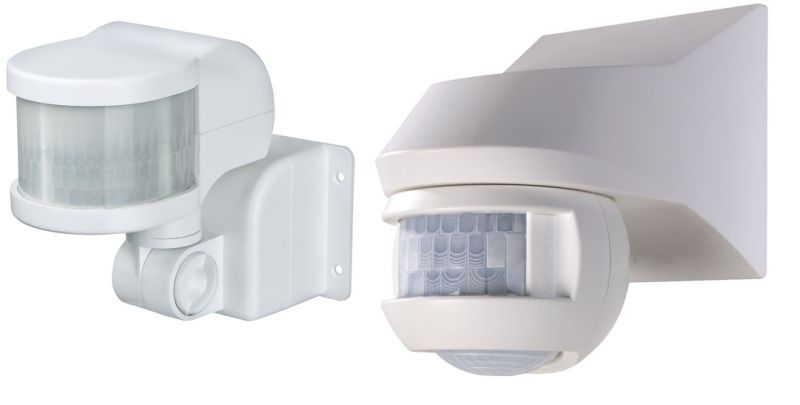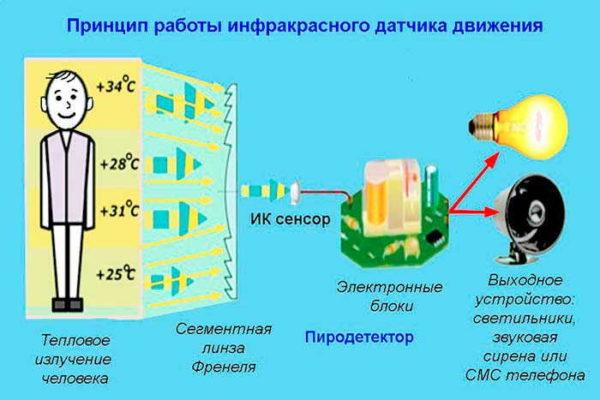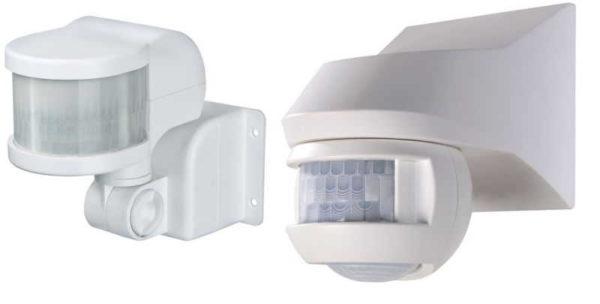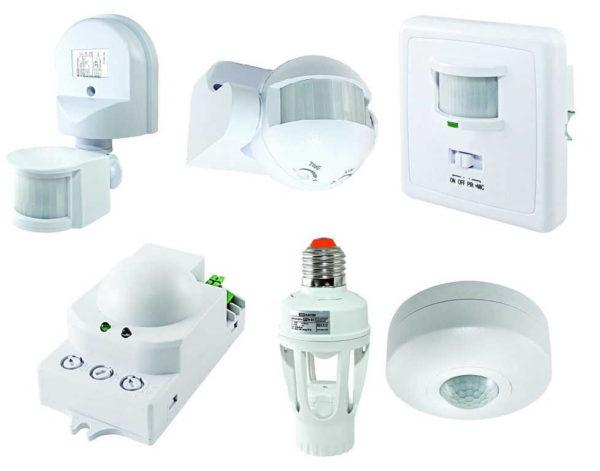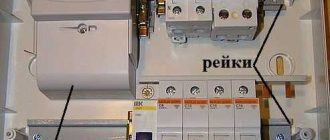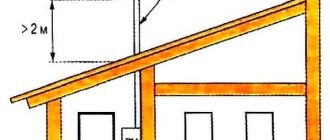It is unreasonable to turn on the lights in some rooms or outdoors for the entire dark period. To ensure that the light is only on when it is needed, a motion sensor is installed in the power supply circuit of the luminaire. In the “normal” state it breaks the power supply circuit. When some moving object appears in its area of action, the contacts are closed and the lighting is switched on. After the object disappears from the zone of action, the light turns off. This algorithm of operation has proven itself in street lighting, in the lighting of utility rooms, corridors, basements, entrances and staircases. In general, in those places where people appear only periodically. So for economy and convenience, it is better to put a motion sensor to turn on the light.
Contenu de l'article
Types et variétés
Motion sensors for turning on the light can be of different types, designed for different operating conditions. First of all, it is necessary to look where the device can be installed.
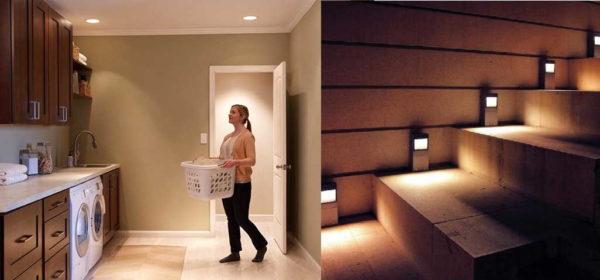
Outdoor motion sensors have a high degree of protection of the housing. For normal operation outdoors take sensors with IP not lower than 55, but better above. For installation in the house you can take IP 22 and higher.
Type of power supply
Next, it is necessary to take into account from what source the light sensor is powered. There are the following options :
The most numerous group – wired for connection to 220 V. Wireless less, but they are also enough. They are good if it is necessary to turn on the lighting, working from low-voltage sources of current – battery or solar panels, for example.
Method of detecting the presence of motion
A motion sensor for switching on lights can detect moving objects using different detection principles:
- Infrared motion sensors. React to the heat generated by the body of warm-blooded creatures. Referred to passive devices, as it does not produce anything itself, only registers radiation. These sensors react to the movement of animals among other things, so there may be false alarms.
- Acoustic motion (noise) sensors. Also belong to the passive group of equipment. They react to noise, can be turned on from a clap, the sound of an open door. They can be used in the basements of private houses, where noise occurs only when someone goes there. In other places the application is limited.
- Microwave motion sensors. Refers to a group of active devices. They themselves produce waves in the microwave range and track their return. In the presence of a moving object, they close/open contacts (there are different types). There are sensitive models that “see” even through partitions or walls. Usually used in security systems.
- Ultrasonic. The principle of action is the same as that of microwave, the range of emitted waves differs. This type of device is rarely used, since animals can react to ultrasound, and prolonged exposure to humans (devices constantly generate radiation) will not benefit.
- Combined (dual). Combine several methods of motion detection. They are more reliable, have fewer false positives, but also more expensive.
Most often, infrared motion sensors are used to turn on the lights on the street or at home. They have a low price, a large range of action, a large number of adjustments that will help to customize it. On stairs and in long corridors it is better to put a sensor with ultrasound or microwave. They are able to turn on the lighting even if you are still far from the light source. In security systems are recommended to install microwave – they detect movement even behind partitions.
Caractéristiques techniques
After determining what motion sensor to turn on the light you will put, you need to pick up its technical characteristics.

Viewing angle
Motion sensor to turn on the light can have a different viewing angle in the horizontal plane – from 90 ° to 360 °. If the object can be approached from any direction, put sensors with a radius of 180-360 ° – depending on its location. If the device is fixed on the wall, 180° is enough, if on a pole – you need 360°. Indoors, you can use those that track movement in a narrow sector.
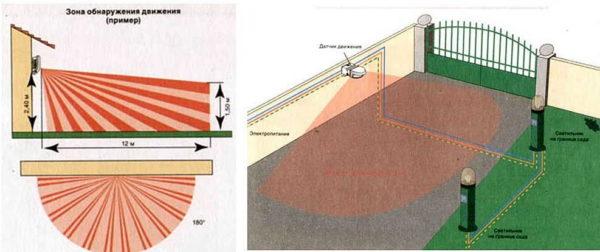
If the door is one (utility room, for example), a narrowband sensor may be sufficient. If the room can be entered from two or three sides, the model should be able to see at least 180 °, and better – in all directions. The wider the “coverage”, the better, but the cost of wide-angle models is much higher, so it is worth proceeding from the principle of reasonable sufficiency.
There is also the angle of view vertically. In ordinary inexpensive models it is 15-20 °, but there are models that can cover up to 180 °. Wide-angle motion detectors are usually put in security systems, not in lighting systems, because the cost is solid. In this regard, it is worth selecting the correct height of installation of the device: so that the “dead zone”, in which the detector simply does not see anything, was not in the place where the movement is the most intense.
Range
Here again, it is worth choosing, taking into account the fact that the motion sensor will be installed indoors to turn on the light or on the street. For indoors, a range of 5-7 meters will be enough.
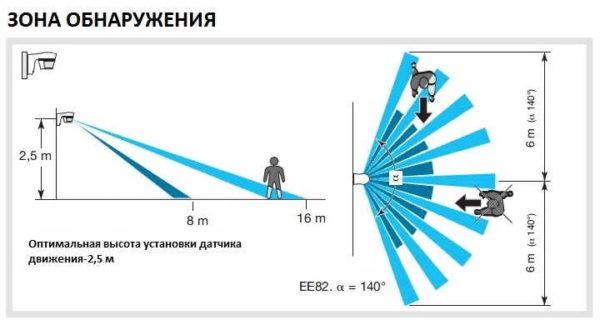
For the street it is desirable to install more “long-range”. But here, too, look: with a large coverage radius, false alarms can be very frequent. So too large a coverage area can even be a disadvantage.
The power of the connected lights
Each motion sensor for switching on lights is designed to connect a specific load – it can carry a certain current rating. Therefore, when choosing, it is necessary to know the total power of the lamps that the device will connect.

In order not to overpay for the increased capacity of the motion sensor, and even save on electricity bills, do not use incandescent lamps, but more economical – discharge lamps, fluorescent or LED.
Installation method and location
In addition to the obvious division into street and “home” there is another type of division on the place of installation of motion sensors:
- Enclosure models. A small box that can be mounted on a bracket. The bracket can be fixed:
- on the ceiling;
- on the wall.
- Recessed models for concealed installation. Miniature models that can be installed in special recesses in an inconspicuous place.
If the lighting is turned on only to increase comfort, choose housing models, as with equal characteristics they are cheaper. Recessed are put in security systems. They are miniaturized, but more expensive.
Fonctions supplémentaires
Some motion detectors have additional features. Some of them are a clear overkill, others, in certain situations, can be useful.
These are all features that can be useful. Especially look out for pet protection and delayed shutdown. These are really useful options.
Where to place
Install a motion sensor to turn on the lighting should be correctly, so that it works correctly, adhere to certain rules:
In large rooms, it is better to install the device on the ceiling. Its viewing radius should be 360°. If the sensor should turn on the lighting from any movement in the room, it is installed in the center, if only some part is controlled, the distance is chosen so that the “dead zone” is minimal.
Motion sensor to turn on the light: installation schemes
In the simplest case, the motion sensor is connected in the gap of the phase wire, which goes to the lamp. If we are talking about a dark room without windows, such a scheme is workable and optimal.
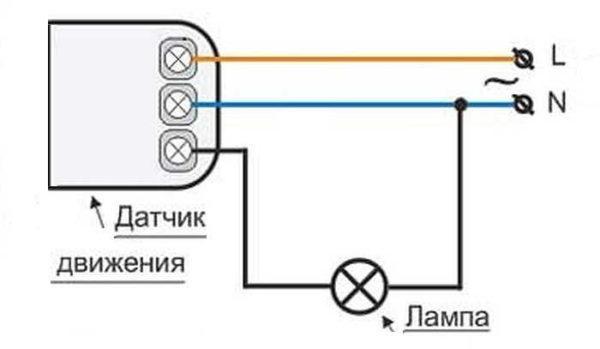
If we talk specifically about the connection of wires, then phase and zero are wound up at the input of the motion sensor (usually signed L for phase and N for neutral). From the output of the sensor phase is fed to the lamp, and zero and ground on it take from the switchboard or from the nearest junction box.
If we are talking about street lighting or turning on the light in a room with windows, it will be necessary to either put a light sensor (photoreluver) or install a switch on the line. Both devices prevent the lights from turning on during daylight hours. Just one (photorelay) works in automatic mode, and the second is turned on forcibly by a person.
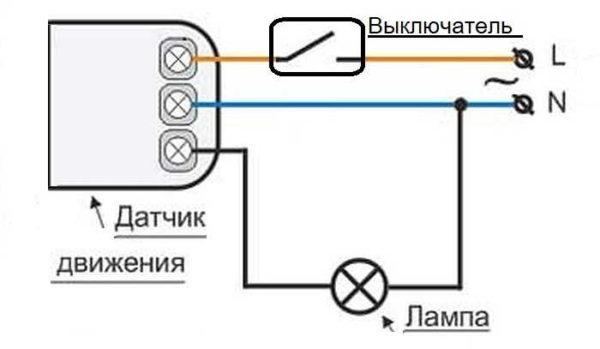
They are also put in the gap of the phase wire. Only when using a light sensor, it must be placed before the motion relay. In this case, it will receive power only after dark and will not work “idle” during the day. Since any electrical device is designed for a certain number of actuations, this will prolong the life of the motion sensor.
All of the above schemes have one disadvantage: the lights can not be turned on for a long time. If you need to do some work on the stairs in the evening, you will have to move all the time, otherwise periodically the light will be turned off.
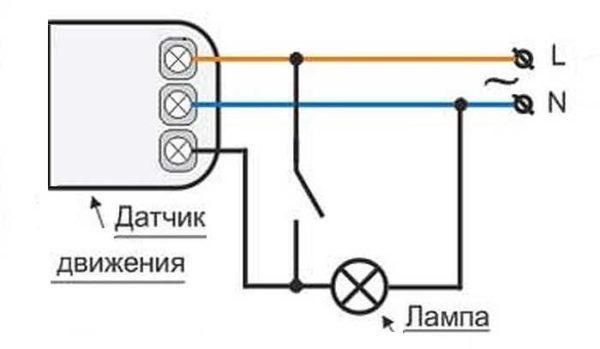
For the possibility of long-term switching on the lighting, a switch is installed in parallel with the detector. While it is off, the sensor is in operation, the light is turned on when it is triggered. If you need to turn on the lamp for a long period of time, you flick the switch. The lamp stays on the entire time until the switch is flicked to the off position again.
Adjustment (setting)
After installation, the motion sensor for switching on the light must be adjusted. There are small rotary knobs on the housing for adjusting almost all parameters. They can be turned by inserting a fingernail into the slot, but it is better to use a small screwdriver. Let’s describe the adjustment of a motion sensor of the DD type with a built-in light sensor, since they are most often put in private houses to automate street lighting.
Tilt angle
For those sensors that are mounted on the walls, first you need to set the angle of inclination. They are fixed on swivel brackets, by means of which their position is changed. It should be chosen so that the controlled area is the largest. Exact recommendations can not be given, because it depends on the angle of vertical view of the model and the height at which you hang it.
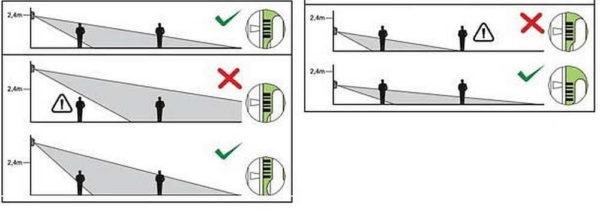
The optimal height for installing a motion sensor is about 2.4 meters. In this case, even those models that can cover only 15-20° vertically control sufficient space. Adjusting the tilt angle is a very rough name for what you’ll have to do. You will change the tilt angle little by little, check how the sensor triggers in this position from different possible entry points. It’s not hard, but it’s a lot of work.
Sensitivity
On the case this adjustment is signed SEN (from English sensitive – sensitivity). The position can be changed from minimum (min/low) to maximum (max/hight).
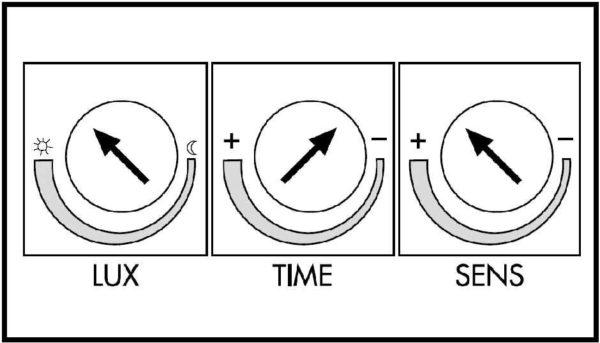
This is one of the most difficult settings, because it depends on whether the sensor will trigger on small animals (cats and dogs). If the dog is large, false alarms cannot be avoided. With medium and small animals it is quite possible. The order of adjustment is as follows: set the sensor to minimum, check how it works for you and smaller animals. If necessary, increase the sensitivity little by little.
Delay time
Different models have a different range of delay time – from 3 seconds to 15 minutes. It is inserted by turning the adjustment wheel. It is usually signed Time.
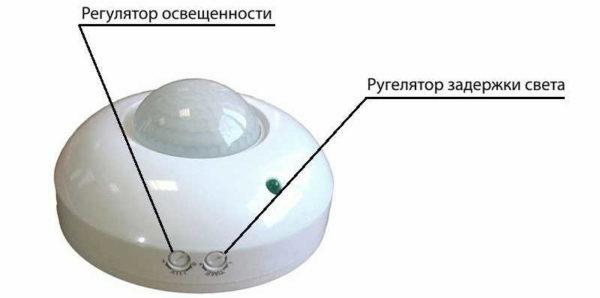
Everything is relatively easy here – knowing the minimum and maximum of your model, approximately choose the position. After turning on the flashlight, you freeze and time the time after which it will turn off. Then you change the position of the regulator in the desired direction.
Light level
This adjustment relates to the photorelay, which we agreed is built into our motion sensor to turn the light on. If there is no built-in photocurrent relay, it simply won’t be there. This adjustment is labeled LUX, with the extreme positions labeled min and max.
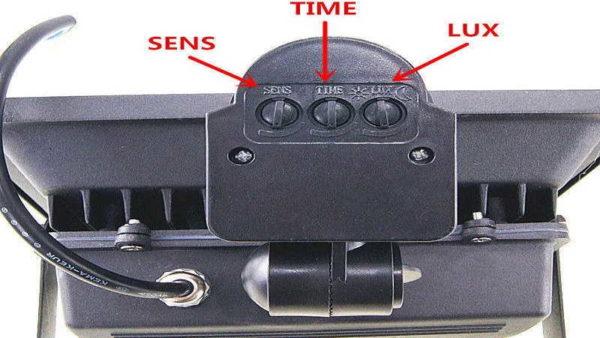
When you connect the regulator, you set it to the maximum position. And in the evening, at the level of illumination, when you think the light should already be on, turn the regulator slowly to the min position until the lamp/flashlight turns on.
Now you can consider that the motion relay is set.

